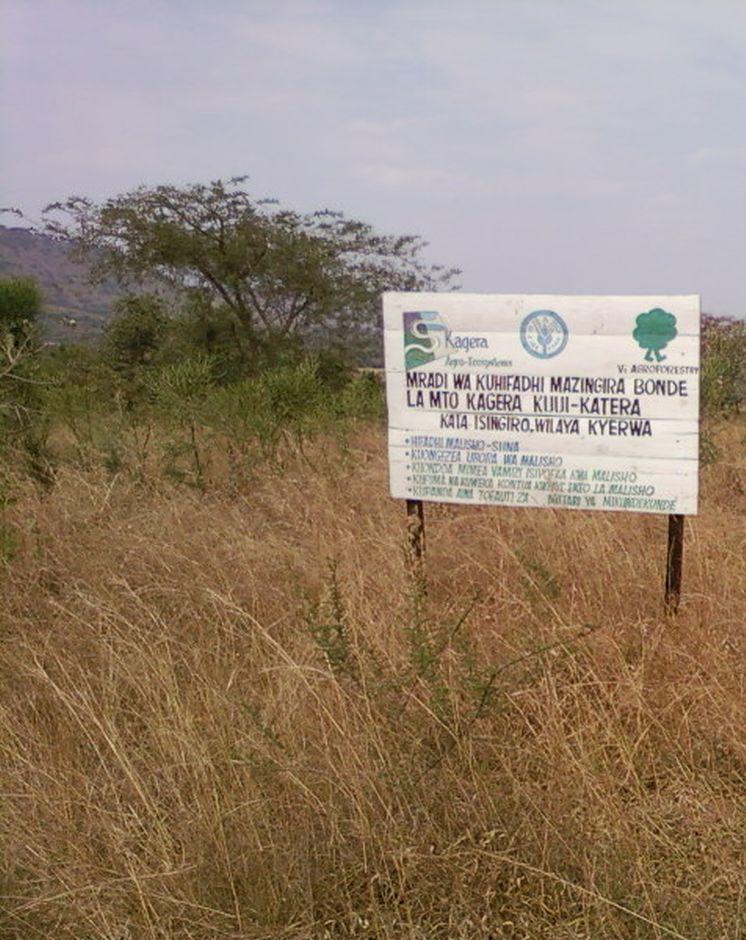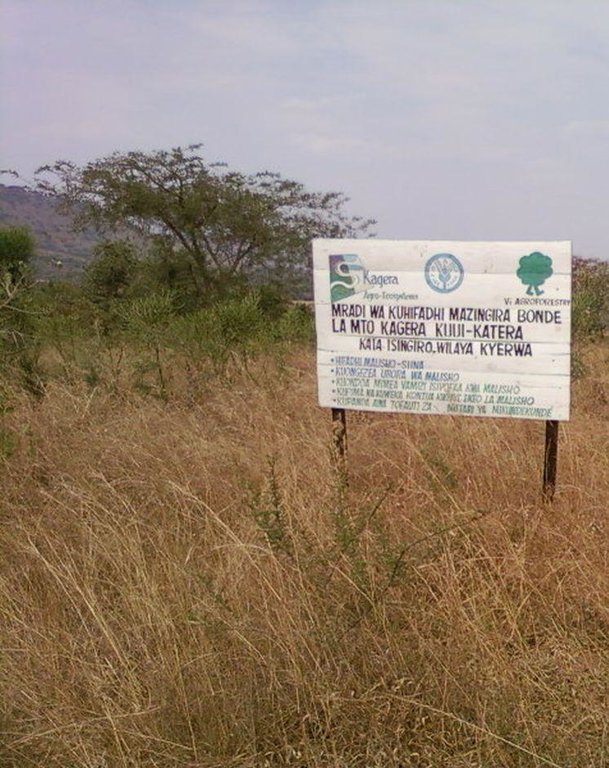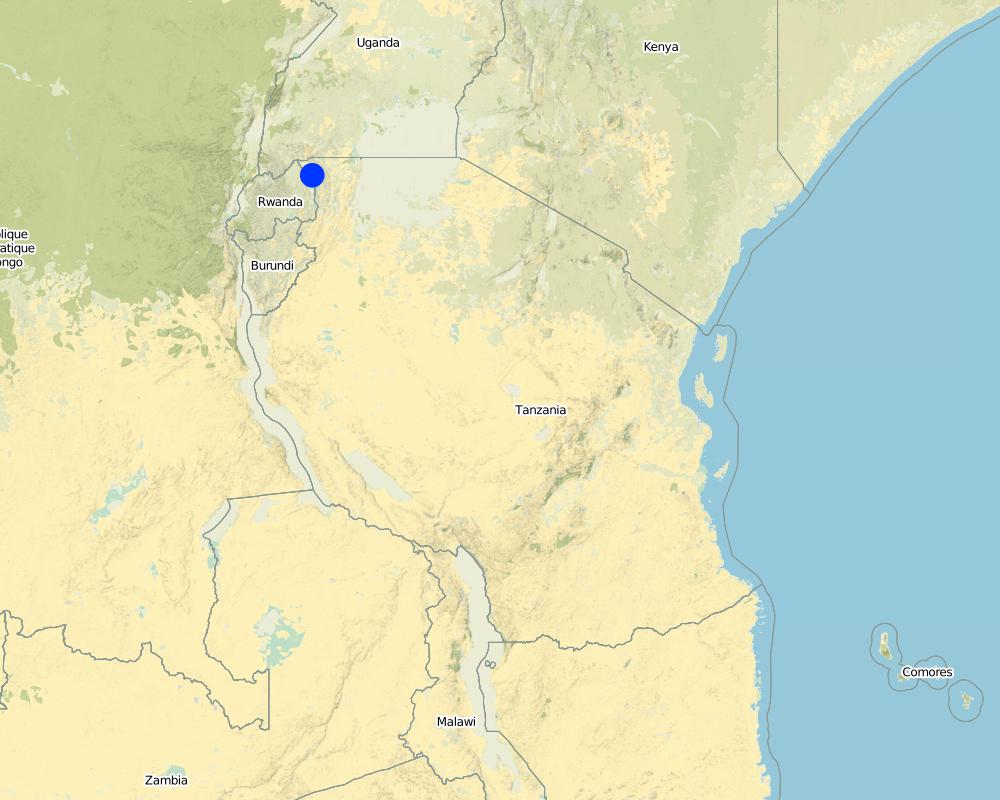Range enclosures [坦桑尼亚联合共和国]
- 创建:
- 更新:
- 编制者: Godfrey Baraba
- 编辑者: –
- 审查者: Fabian Ottiger, Alexandra Gavilano
Hifadhi ya malisho
technologies_1612 - 坦桑尼亚联合共和国
查看章节
全部展开 全部收起1. 一般信息
1.2 参与该技术评估和文件编制的资源人员和机构的联系方式
SLM专业人员:
Pesha Wambura
Kyerwa District Council
坦桑尼亚联合共和国
SLM专业人员:
Bubelwa Allani
Misenyi District Council
坦桑尼亚联合共和国
有助于对技术进行记录/评估的机构名称(如相关)
Missenyi District Council (Missenyi District Council) - 坦桑尼亚联合共和国有助于对技术进行记录/评估的机构名称(如相关)
Bukoba district council (Bukoba district council) - 坦桑尼亚联合共和国有助于对技术进行记录/评估的机构名称(如相关)
Kyerwa District Council - 坦桑尼亚联合共和国1.3 关于使用通过WOCAT记录的数据的条件
编制者和关键资源人员接受有关使用通过WOCAT记录数据的条件。:
是
1.4 所述技术的可持续性声明
这里所描述的技术在土地退化方面是否存在问题,导致无法被认为是一种可持续的土地管理技术?:
否
2. SLM技术的说明
2.1 技术简介
技术定义:
Is the restriction, reseedling of desmodium decoloratum, stylothensis hamata and Stilozobium spps in the demarcated overgrazed land.
2.2 技术的详细说明
说明:
The grazing land enclosure combined with quality pastures’ reseeding is the identification and demarcation of the degraded grazing land, reseeding palatable grass species and legumes with application of rotational grazing system. The technology is applied on the grazing land in the tropics, sub humid, gentle undulating upland, seasonal swamps to ensure SaLM with increased quantity and quality of pasture production. The land cultivation is done manually using hand hoes, in the mixed production system. The land ownership is communal and the land use right is organized (grazing land is demarcated) for all livestock keepers to graze their livestock. The establishment procedures includes planting of Euphobia spps along the borders, reseeding palatable grasses spps on the bare spots, plough and drill legume seeds intergraded with grasses. The maintenance procedures require range patrol, paddocks (fences and roads) maintenance. The average cost to establish one hector of the technology is US$ 122.11 while the maintenance of one hector is US$ 41.72 the technology was introduced by Kagera TAMP in 2012 using FFS methodology. Hay making is considered to be supportive technology that can add effectiveness to the main technology.
Purpose of the Technology: The major purpose is to restore soil vegetative cover, increase biomass, increase soil nutrient cycling, reduce soil moisture stress and diversify pasture species, for recommended carrying capacity attainments.
Establishment / maintenance activities and inputs: The establishment activities include; first identification and demarcation of degraded grazing land done in June. Second is broadcasting improved pasture seeds (Chloris gayana and Congo signal) done in late August. Third is establishment of live fence (planting Euphobia spps, sisal seedling and mikwatango) done in September. Fourth is cultivation of bare land spots and drill legume seeds (Stylosthensis hamata, centocema pubences etc) or plant improved legume cuttings (Desmodium coloratum). The maintenance activities includes; first weeding invasive species (sida accuta, Duratura stromonium etc) done manually using hand hoes and machete in June and January. Second is fire break cleaning done manually using hand hoes in May and December. Last but not least to importance is range patrol done routinely.
Natural / human environment: The human environments includes wealthy stutus as 13% poor land user, 50% average land users and 37% rich land users owning the land ownership is communal. The land cultivation is done manually using hand hoes. The production system is mixed in the sense that, live cull cows and steers are for sale while small ruminants and milk are for both domestic consumption and sales of excess.
2.3 技术照片
2.5 已应用该技术的、本评估所涵盖的国家/地区/地点
国家:
坦桑尼亚联合共和国
区域/州/省:
Tanzania
有关地点的进一步说明:
Kyerwa
具体说明该技术的分布:
- 均匀地分布在一个区域
如果不知道精确的区域,请注明大致覆盖的区域:
- < 0.1 平方千米(10 公顷)
Map
×2.6 实施日期
如果不知道确切的年份,请说明大概的日期:
- 不到10年前(最近)
2.7 技术介绍
详细说明该技术是如何引入的:
- 通过项目/外部干预
注释(项目类型等):
FFS trained on land conservations in Katera hifadi ya malisho group using pasture improvemnt as indicor crop.
3. SLM技术的分类
3.1 该技术的主要目的
- 减少、预防、恢复土地退化
- 保持/提高生物多样性
3.2 应用该技术的当前土地利用类型
同一土地单元内混合使用的土地::
是
具体说明混合土地使用(作物/放牧/树木):
- 农牧业(包括农牧结合)

农田
每年的生长季节数:
- 2
具体说明:
Longest growing period in days: 120, Longest growing period from month to month: November to February Second longest growing period in days: 90 Second longest growing period from month to month: March to May

牧场
- Bovine, caprine and ovine
注释:
Livestock density (if relevant):
> 100 LU /km2
Major land use problems (compiler’s opinion): The major land use problem related to soil, water and vegetation in the area was loss of palatable spps, reduced vegetative cover and ....
Major land use problems (land users’ perception): The major land use problem was poor/ inadequate pastures.
Mixed: (eg agro-pastoralism, silvo-pastoralism): bovine, caprine and ovine
3.4 供水
该技术所应用土地的供水:
- 雨养
注释:
Water supply: Also post-flooding
3.5 该技术所属的SLM组
- 区域封闭(停止使用,支持恢复)
3.6 包含该技术的可持续土地管理措施

管理措施
- M2:改变管理/强度级别
- M5:物种组成的控制/变化
3.7 该技术强调的主要土地退化类型

土壤水蚀
- Wt:表土流失/地表侵蚀

物理性土壤退化
- Pc:压实

生物性退化
- Bc:植被覆盖的减少
- Bq:数量/生物量减少
- Bf:火灾的有害影响
- Bs:质量和物种组成/多样性的下降
注释:
Main causes of degradation: overgrazing (Livestock holding density in the area is 116 per square km.), change of seasonal rainfall (dry spel tends to prolong in long rain seasons.), droughts (the area experiences a long drought period.), land tenure (difficult to control grazing regimes in the communal owned land.), governance / institutional (leizure fair on grazing land control resulted into cattle influxes in the area.)
3.8 防止、减少或恢复土地退化
具体数量名该技术与土地退化有关的目标:
- 防止土地退化
- 减少土地退化
4. 技术规范、实施活动、投入和成本
4.1 该技术的技术图纸
技术规范(与技术图纸相关):
Technical knowledge required for field staff / advisors: low (Basic principles of pasture management is taught at colleges.)
Technical knowledge required for land users: moderate (Leguminous spps re seedlings requires new knowledge.)
Main technical functions: improvement of ground cover, increase in organic matter, increase in nutrient availability (supply, recycling,…), promotion of vegetation species and varieties (quality, eg palatable fodder), control of fires
Secondary technical functions: increase / maintain water stored in soil, increase of biomass (quantity)
Change of land use practices / intensity level: Instead of continuous grazing, rotational grazing is recommended to reduces the frequencies of livestock trumping the land.
Control / change of species composition: In the overgrazed land palatable spps had lost while unpalatable spps dominated. Furthermore, legumes for quality improvement had disappeared.
4.2 有关投入和成本计算的一般信息
其它/国家货币(具体说明):
Tshs
如相关,注明美元与当地货币的汇率(例如1美元=79.9巴西雷亚尔):1美元=:
1700.0
注明雇用劳工的每日平均工资成本:
1.88
4.3 技术建立活动
| 活动 | 时间(季度) | |
|---|---|---|
| 1. | To identify the degraded grazing land. | |
| 2. | To plant Euphobia triculi | |
| 3. | To plat sisal | |
| 4. | To plat elephant grass | |
| 5. | To reseed legumes | |
| 6. | To clear fire break along the demarcated borders. |
4.4 技术建立所需要的费用和投入
| 对投入进行具体说明 | 单位 | 数量 | 单位成本 | 每项投入的总成本 | 土地使用者承担的成本% | |
|---|---|---|---|---|---|---|
| 劳动力 | Labour | ha | 1.0 | 13.8 | 13.8 | |
| 植物材料 | Seeds | ha | 1.0 | 119.02 | 119.02 | |
| 植物材料 | Seedlings | ha | 1.0 | 3.09 | 3.09 | |
| 技术建立所需总成本 | 135.91 | |||||
| 技术建立总成本,美元 | 0.08 | |||||
4.5 维护/经常性活动
| 活动 | 时间/频率 | |
|---|---|---|
| 1. | To remove invasive spps (shrubs/weeds) | |
| 2. | To clean the fire break | June and December |
4.6 维护/经常性活动所需要的费用和投入(每年)
| 对投入进行具体说明 | 单位 | 数量 | 单位成本 | 每项投入的总成本 | 土地使用者承担的成本% | |
|---|---|---|---|---|---|---|
| 劳动力 | Labour | ha | 1.0 | 41.73 | 41.73 | 100.0 |
| 技术维护所需总成本 | 41.73 | |||||
| 技术维护总成本,美元 | 0.02 | |||||
5. 自然和人文环境
5.1 气候
年降雨量
- < 250毫米
- 251-500毫米
- 501-750毫米
- 751-1,000毫米
- 1,001-1,500毫米
- 1,501-2,000毫米
- 2,001-3,000毫米
- 3,001-4,000毫米
- > 4,000毫米
有关降雨的规范/注释:
800mm bimodol (march to May and November to January)
农业气候带
- 半湿润
Thermal climate class: tropics. All months has a temperature above 18°C. LGP is 180 to 210 days
5.2 地形
平均坡度:
- 水平(0-2%)
- 缓降(3-5%)
- 平缓(6-10%)
- 滚坡(11-15%)
- 崎岖(16-30%)
- 陡峭(31-60%)
- 非常陡峭(>60%)
地形:
- 高原/平原
- 山脊
- 山坡
- 山地斜坡
- 麓坡
- 谷底
垂直分布带:
- 0-100 m a.s.l.
- 101-500 m a.s.l.
- 501-1,000 m a.s.l.
- 1,001-1,500 m a.s.l.
- 1,501-2,000 m a.s.l.
- 2,001-2,500 m a.s.l.
- 2,501-3,000 m a.s.l.
- 3,001-4,000 m a.s.l.
- > 4,000 m a.s.l.
关于地形的注释和进一步规范:
Landforms: Footslopes (ranked 1, UP), hillsopes (MS) and mountain slopes (EP, both ranked 2)
Slopes on average: Gentle (bordering the valley) and moderate (bordering the hill slopes)
5.3 土壤
平均土层深度:
- 非常浅(0-20厘米)
- 浅(21-50厘米)
- 中等深度(51-80厘米)
- 深(81-120厘米)
- 非常深(> 120厘米)
土壤质地(表土):
- 中粒(壤土、粉土)
表土有机质:
- 低(<1%)
如有可能,附上完整的土壤描述或具体说明可用的信息,例如土壤类型、土壤酸碱度、阳离子交换能力、氮、盐度等。:
Soil depth on average: Shallow (laying over ironstone gravel)
Soil texture: Medium (friable redish brown to brown, with fine to coarse sand)
Soil fertility: Low
Topsoil organic matter: Low (bare spots dominated)
Soil drainage/infiltration: Medium
Soil water storage capacity: Low
5.4 水资源可用性和质量
地下水位表:
> 50米
地表水的可用性:
好
水质(未处理):
良好饮用水
关于水质和水量的注释和进一步规范:
Availability of surface water: Good (the range borders lake Kagenyi)
Water quality (untreated): Good drinking water (available gravity tape water from .....sources)
5.5 生物多样性
物种多样性:
- 低
关于生物多样性的注释和进一步规范:
Dominated bare spots and dry soils.
5.6 应用该技术的土地使用者的特征
非农收入:
- 低于全部收入的10%
个人或集体:
- 团体/社区
性别:
- 女人
- 男人
说明土地使用者的其他有关特征:
Land users applying the Technology are mainly common / average land users
Relative level of wealth: rich, average, poor
37% of the land users are rich.
50% of the land users are average wealthy.
13% of the land users are poor.
Off-farm income specification: opportunity costs of technology application minimized the opportunity to invest and maintain off-farm activities.
5.7 应用该技术的土地使用者使用的平均土地面积
- < 0.5 公顷
- 0.5-1 公顷
- 1-2 公顷
- 2-5公顷
- 5-15公顷
- 15-50公顷
- 50-100公顷
- 100-500公顷
- 500-1,000公顷
- 1,000-10,000公顷
- > 10,000公顷
这被认为是小规模、中规模还是大规模的(参照当地实际情况)?:
- 中等规模的
注释:
A communal grazing land is 152sqkm over 1040 house-holds
5.8 土地所有权、土地使用权和水使用权
土地所有权:
- 社区/村庄
土地使用权:
- 自由进入(无组织)
用水权:
- 自由进入(无组织)
注释:
A 3 hectare piece of communal grazing land alocated for a group of 35 members to undergo the SLM training.
5.9 进入服务和基础设施的通道
健康:
- 贫瘠
- 适度的
- 好
教育:
- 贫瘠
- 适度的
- 好
技术援助:
- 贫瘠
- 适度的
- 好
就业(例如非农):
- 贫瘠
- 适度的
- 好
市场:
- 贫瘠
- 适度的
- 好
能源:
- 贫瘠
- 适度的
- 好
道路和交通:
- 贫瘠
- 适度的
- 好
饮用水和卫生设施:
- 贫瘠
- 适度的
- 好
金融服务:
- 贫瘠
- 适度的
- 好
6. 影响和结论性说明
6.1 该技术的现场影响
社会经济效应
生产
饲料生产
SLM之前的数量:
1
SLM之后的数量:
1.5
注释/具体说明:
DM yield improved after reducing trampling and bushfires.
饲料质量
SLM之前的数量:
3
SLM之后的数量:
17
注释/具体说明:
Legumes intercroping had fixed nitogen in the soil.
畜牧生产
SLM之前的数量:
50
SLM之后的数量:
170
注释/具体说明:
liveweight gain per anum improved due to optimum DM -intake and DCP availability. .
生产故障风险
收入和成本
农业投入费用
注释/具体说明:
cost of desmodium, stylothensis hamata and Nappier grass
工作量
注释/具体说明:
labour demanded for extra activities.
社会文化影响
食品安全/自给自足
社区机构
SLM之前的数量:
0
SLM之后的数量:
3
注释/具体说明:
group members can organize themselves to conserve the rest of the overgrazed area
SLM/土地退化知识
SLM之前的数量:
low
SLM之后的数量:
moderate
注释/具体说明:
a training site shown positve results after six months of implimentation.
社会经济弱势群体的情况
注释/具体说明:
FFF group members includes all genders.
Improved livelihoods and human well-being
注释/具体说明:
The effective duration of technology implimentation is too short to meet technology upscaling to suit the farming scale (medium scale ie. 100-300 cattle) herd size.
生态影响
水循环/径流
地表径流
注释/具体说明:
grasses impends water run -off
土壤
土壤水分
注释/具体说明:
grasses covered soil surfaces
土壤覆盖层
SLM之前的数量:
50
SLM之后的数量:
90
注释/具体说明:
no bare spot found in the field.
土壤流失
土壤压实
注释/具体说明:
cattle restrivted to tramp the soils.
养分循环/补给
注释/具体说明:
planted desmodium and stylothensis hamata
生物多样性:植被、动物
生物量/地上C
植物多样性
注释/具体说明:
mixture of grasses and legumes.
害虫/疾病控制
注释/具体说明:
snakes and rodents are hinding in tall grasses.
减少气候和灾害风险
火灾风险
注释/具体说明:
firebreak constructed along the borders.
6.3 技术对渐变气候以及与气候相关的极端情况/灾害的暴露和敏感性(土地使用者认为的极端情况/灾害)
气候有关的极端情况(灾害)
气候灾害
| 该技术是如何应对的? | |
|---|---|
| 干旱 | 好 |
其他气候相关的后果
其他气候相关的后果
| 该技术是如何应对的? | |
|---|---|
| 缩短生长期 | 好 |
6.4 成本效益分析
技术收益与技术建立成本相比如何(从土地使用者的角度看)?
短期回报:
消极
长期回报:
中性/平衡
技术收益与技术维护成本/经常性成本相比如何(从土地使用者的角度看)?
短期回报:
轻度消极
长期回报:
稍微积极
注释:
The short term retuns compared with establishment is negative due to distocking requirement to suit the recommended carrying capacity. The long term return anticipated to be positive due to increased livestock density projecting increased off-take rates.
The short term return compared with maintenance is slightly negative as a result of increased costs of restriction. The long run return compared with maintenance is positve due to reduced costs of restriction while rotational grazing can simply suit the technology.
6.5 技术采用
注释:
35% of land user families have adopted the Technology with external material support
35 land user families have adopted the Technology with external material support
Comments on acceptance with external material support: A total of 35 group members attended the FFS and applied the technology in a portion of communal grazing land.
Comments on spontaneous adoption: The effective duration is to short for neither group members nor non group members to comply with the land policy requirement to acquire the land for technology implementation.
There is no trend towards spontaneous adoption of the Technology
Comments on adoption trend: The communal land tenure applied in the area is a major obstacle for technology adoption. ie. the habit of open access rights for land use make it difficult to enclosure the require size of land in order to up scale the technology.
6.7 该技术的优点/长处/机会
| 土地使用者眼中的长处/优势/机会 |
|---|
| It is simple to learn and understand. |
| In a short period of six months, the change was very distinct ie. grass covered the bare spot on soils, while in the dry spell the standing hay harvested to feed calves. |
6.8 技术的弱点/缺点/风险及其克服方法
| 编制者或其他关键资源人员认为的弱点/缺点/风险 | 如何克服它们? |
|---|---|
| Difficult to transfer the knowledge into communal grazing land (overstocked >100LU/sqkm) without grazing land act enforcement. | Enforce grazing land and animal feed resources act. |
| The restriction of cattle to graze in the enclosure means twice as much land required for a significant short term returns. | Educate land users on carrying capacity importance. |
7. 参考和链接
7.1 信息的方法/来源
- 实地考察、实地调查
- 与土地使用者的访谈
(现场)数据是什么时候汇编的?:
25/07/2014
链接和模块
全部展开 全部收起链接
无链接
模块
无模块




